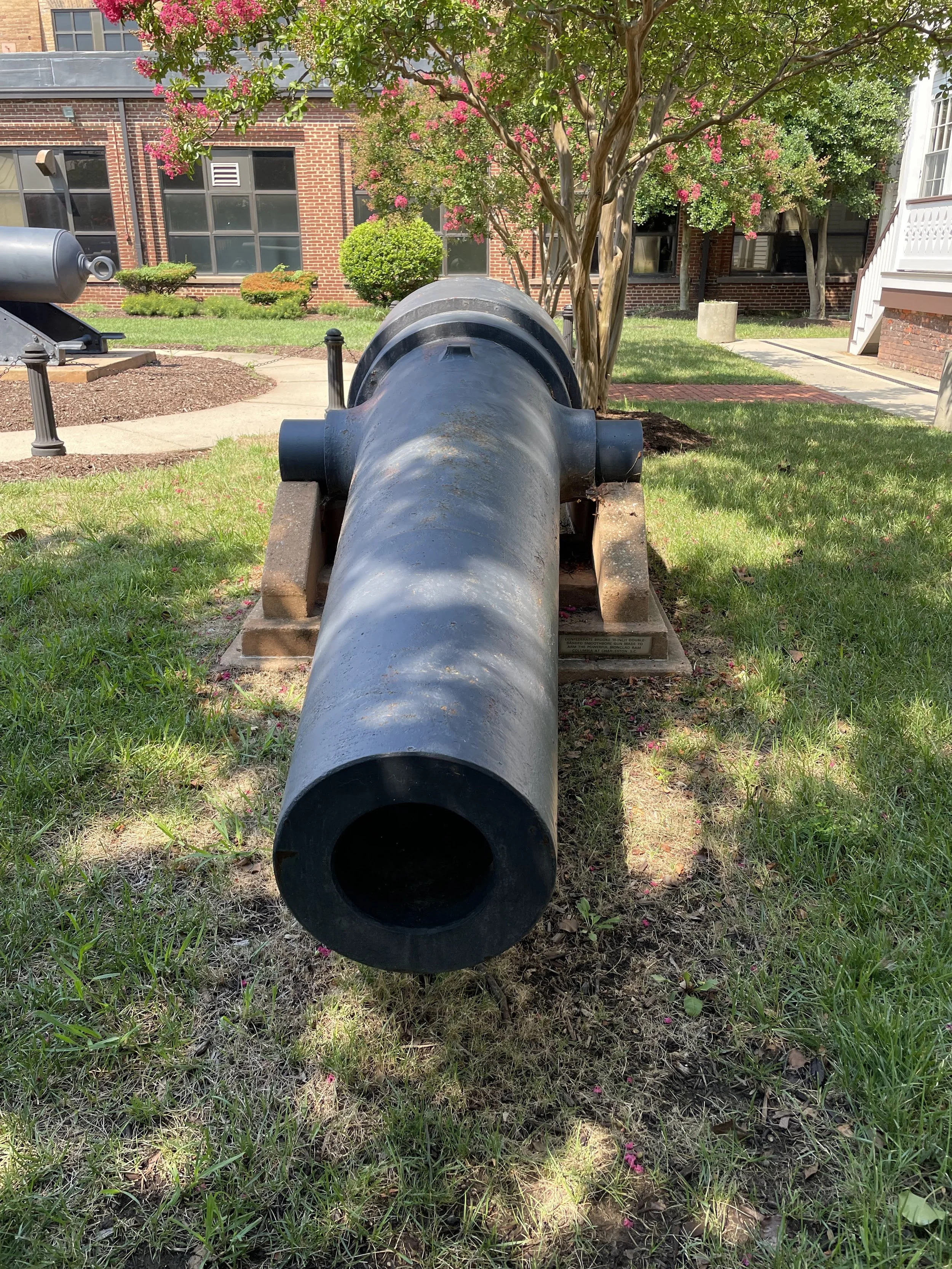The 10-Inch Brooke Smoothbore of CSS Columbia
A 10-Inch Brooke Smoothbore manufactured by Tredegar in 1864 for installation aboard CSS Columbia is displayed as a trophy at the Washington Navy Yard. In the background are a 7-Inch Brooke Rifle of CSS Tennessee (left) and the 12-Inch "Mersey Gun" (right).
The largest single collection of Confederate Brooke cannons are the trophies displayed at the Washington Navy Yard. Eight of the cannons are rifles: four single-banded Brooke Rifles captured aboard CSS Atlanta and four double-banded Brooke Rifles captured aboard CSS Tennessee.
The ninth is a 10-Inch Brooke Smoothbore. It was manufactured for the ironclad CSS Columbia which was built at Charleston. According to Warren Ripley’s Artillery and Ammunition of the Civil War, it is unknown whether the 10-Inch Brooke was aboard Columbia when that ship was captured after US forces took Charleston in February of 1865. Ripley also states that the 10-Inch and 11-Inch Brooke smoothbores were designed to fire wrought iron shot propelled by heavy charges against ironclads (Ripley, pg. 130).
The 10-Inch Brooke at the Washington Navy Yard is marked as being manufactured by Tredegar in 1864 and weighing 21,140 pounds, according to the information in the registry in the appendix of The Big Guns. The National Civil War Naval Museum in Columbus, Georgia displays the only other surviving 10-Inch Brooke along with an 11-Inch Brooke smoothbore as well.
Rear Admiral John Dahlgren’s Report to Secretary Wells on CSS Columbia
US Flagship Philadelphia, Charleston Harbor
June 1st, 1865
Official Records - Navies. Series 1. Vol. 16. pp. 387-388
Up a small creek was found a fourth ironclad, the Columbia, of the same size as the Charleston, but plated with 6 inches of iron. A new, well-built vessel just ready for service.
It seems that about a month before the entrance of the Union forces (January 12), the vessel had been docked in the creek above the city and in getting her out she grounded.
The rebels seem to have begun to extricate the vessel, but had not sufficient time before they abandoned Charleston. Why she was not destroyed is difficult to conceive, as they sunk the three that were in service and burned two new ironclads that were not completed.
This vessel was fully ready for service, even guns mounted, which it was said were taken out after grounding, and a portion of the plating had been removed as a preparation for lightening and floating the vessel.
Under the belief that the vessel could be saved, I gave the necessary directions, and on the 26th had the satisfaction of seeing her floated, which was effected by exertions of several officers: Lieutenant-Commander Matthews, Fleet Engineer Danby, Chief Engineer Kiersted, by Master Carpenter Davies, by Lieutenant Churchill, and the divers.
This vessel has an extreme length of 216 feet: beam, 51 1/2 feet; is plated with 6 inches of iron; carries six guns of the heaviest caliber; has two engines, high pressure; ample accommodations on berth deck for cabin, wardroom and men, with good quarters in the casemates.
Her leakage is very small, indicating no great injury from the grounding.
Her steam power was in good order, only requiring the stack pipe and smoke box to be replaced, and some of the interior pipe that had been cut. The Columbia left on the 23d May in tow of the Vanderbilt, and was commanded by Lieutenant Hayward.
I propose to place four of my own new X-inch guns in the casemate, one at each corner; they way about 16,000 pounds, and will throw a solid shot, with 40 pounds of powder, which has pierced 4 1/2 inches of good iron at 200 yards. If the two other guns are needed, they may be of IX-inch.
Sketch of CSS Columbia included with Admiral Dahlgren’s Report to Secretary Wells











